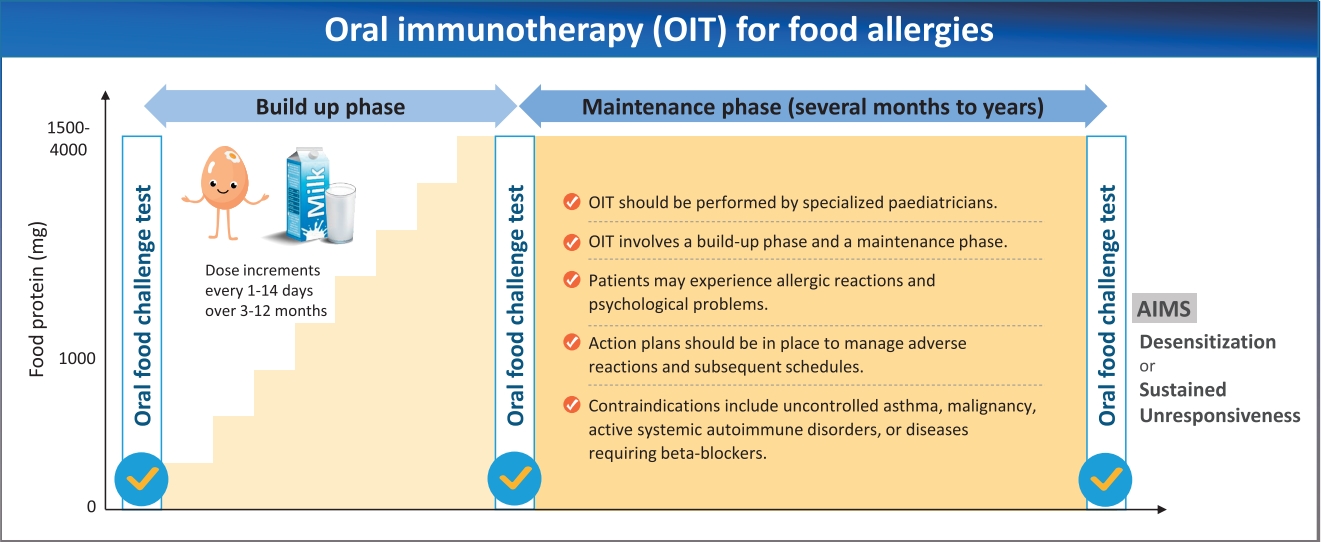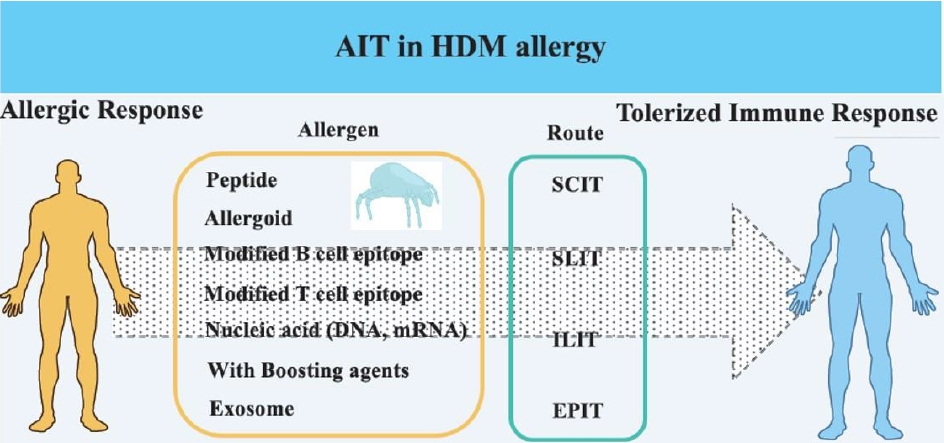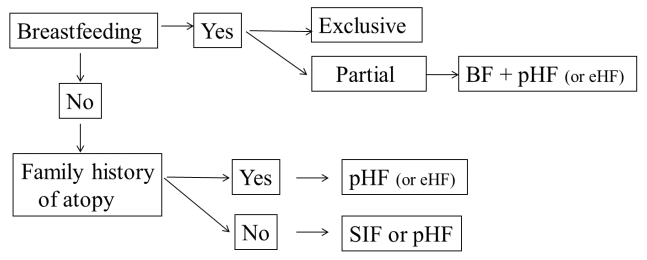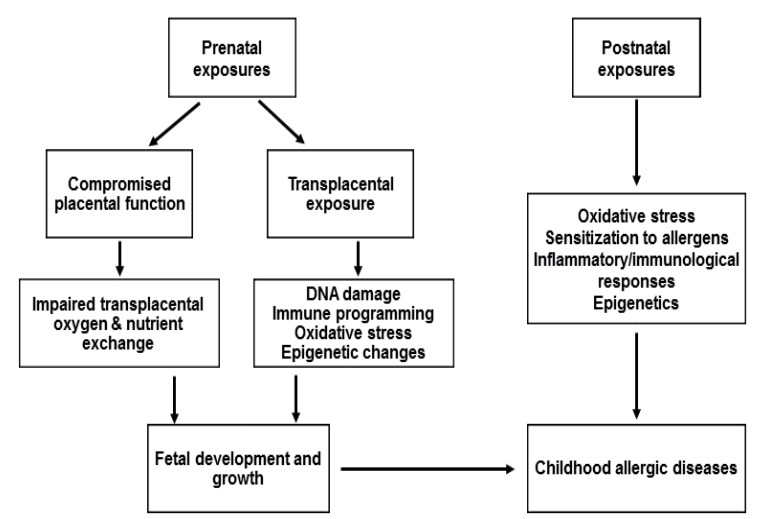Search
- Page Path
-
- HOME
- Search
- Original Article
- Allergy
- Regional differences in diagnosis and management of cow's milk allergy
- Fabian Hendricx, Emma Robert, Jaime A. Ramirez-Mayans, Karen Rubi Ignorosa Arellano, Erick M. Toro Monjaraz, Yvan Vandenplas
- Clin Exp Pediatr. 2024;67(11):601-607. Published online October 28, 2024
-

· Although there is broad consensus on many aspects regarding the symptoms, diagnosis, and treatment of cow's milk allergy, the impact of geographical, cultural, and socioeconomic factors remains unestablished.
· Availability and cost of formula for the management of cow's milk allergy have a major impact on the therapeutic choice.
· Region-specific guidelines for the treatment of cow's milk allergy are required.
- Review Article
- Allergy
- Recent advances in food allergen immunotherapy
- You Hoon Jeon, Edwin H. Kim
- Clin Exp Pediatr. 2024;67(8):386-394. Published online December 7, 2023
-

· To enhance the safety of food allergen immunotherapy, alternative approaches such as sublingual immunotherapy, epicutaneous immunotherapy, low-dose oral immunotherapy (OIT), and omalizumab with OIT are being explored.
· Factors such as causative allergen type, natural outgrowth, symptom severity, and patient age should be considered.
· Individualized food allergen immunotherapy plans should be established to determine the most beneficial treatment for each patient.
- Practical issues of oral immunotherapy for egg or milk allergy
- Sukyung Kim, Kangmo Ahn, Jihyun Kim
- Clin Exp Pediatr. 2024;67(3):140-148. Published online June 19, 2023
-

· Oral immunotherapy should be supervised by pediatricians with experience administering oral food challenge tests and managing allergic reactions.
· Food allergen intake is gradually increased and maintained for years.
· Patients may experience allergic reactions and psychological problems.
· Adjunctive therapies (biologics, antihistamines, and leukotriene receptor antagonists) may improve efficacy and safety.
· Contraindications include uncontrolled asthma, malignancy, active autoimmune disorders, and beta-blocker usage.
- Skin and oral intervention for food allergy prevention based on dual allergen exposure hypothesis
- Kiwako Yamamoto-Hanada, Yukihiro Ohya
- Clin Exp Pediatr. 2024;67(10):477-485. Published online June 14, 2023
-

To prevent food allergy in infants, based on the dual allergen exposure hypothesis, we recommend a personalized approach consisting of both skin intervention (eczema treatment to achieve early remission and well-controlled skin without eczema to prevent percutaneous immunoglobulin E sensitization) and oral intervention (early allergenic food introduction).
- New approaches to immunotherapy in house dust mite allergy
- In Sik Kim
- Clin Exp Pediatr. 2023;66(4):161-168. Published online October 25, 2022
-

Allergen immunotherapy (AIT) has developed over the last few decades and has emerged as a promising treatment. House dust mite (HDM) is a target allergen in AIT, and various modified HDM allergens have been improved for their efficacy. Moreover, clinical trials have proved their significantly therapeutic effects in allergy. This article review focuses on HDM allergens developed for AIT efficacy,...
- Drug Allergy in Children: What Should We Know?
- Ji Soo Park, Dong In Suh
- Clin Exp Pediatr. 2020;63(6):203-210. Published online November 12, 2019
-

The drug allergy “label” may have a lifetime of consequences for a child. Many children with alleged drug allergies are proven to be tolerant to the culprit medication when challenged. The field of drug hypersensitivity is a recently evolving field of research, but studies on its epidemiology and diagnostic tools are lacking in children. Clinical history is significant in the...
- Original Article
- Allergy
- Asthma predictive index as a useful diagnostic tool in preschool children: a cross-sectional study in Korea
- Dong Hyeon Lee, Ji-Won Kwon, Hyung Young Kim, Ju-Hee Seo, Hyo-Bin Kim, So-Yeon Lee, Gwang-Cheon Jang, Dae-Jin Song, Woo Kyung Kim, Young-Ho Jung, Soo-Jong Hong, Jung Yeon Shim
- Clin Exp Pediatr. 2020;63(3):104-109. Published online November 8, 2019
-

Question: Is physician-diagnosed current asthma in preschool children associated with the asthma predictive index, atopic sensitization, or pulmonary function test?
Finding: Physician-diagnosed current asthma in preschool children was associated with the asthma predictive index, but not with spirometry, methacholine provocation test, fractional expiratory nitric oxide level, and atopic sensitization.
Meaning: Physician-diagnosed asthma in preschool children may be different from classic atopic asthma in school children or adolescents.
- Review Article
- Nutrition
- A perspective on partially hydrolyzed protein infant formula in nonexclusively breastfed infants
- Yvan Vandenplas, Zakiudin Munasir, Badriul Hegar, Dewi Kumarawati, Ahmad Suryawan, Muzal Kadim, Julistio Tb Djais, Ray Wagiu Basrowi, Deni Krisnamurti
- Clin Exp Pediatr. 2019;62(5):149-154. Published online January 14, 2019
-

The World Health Organization recommends that infants should be exclusively breastfed for the first 6 months of life to provide optimal nutrition in this critical period of life. After this, infants should receive nutritionally adequate and safe complementary foods while breastfeeding continues for up to 2 years of age or beyond. For nonbreastfed infants, infant formula is an available option...
- Allergy
- Particulate matter and childhood allergic diseases
- Song-I Yang
- Clin Exp Pediatr. 2019;62(1):22-29. Published online November 7, 2018
-

Particulate matter (PM) is a ubiquitous air pollutant that is a growing public health concern. Previous studies have suggested that PM is associated with asthma development and exacerbation of asthma symptoms. Although several studies have suggested increased risks of atopic dermatitis, allergic rhinitis, and allergic sensitization in relation to PM exposure, the evidence remains inconsistent. The plausible mechanisms underlying these...
- Original Article
- Allergy
Clostridium difficile colonization and/or infection during infancy and the risk of childhood allergic diseases- Sun Hwa Lee, Yun Na Gong, Eell Ryoo
- Clin Exp Pediatr. 2017;60(5):145-150. Published online May 31, 2017
-
Purpose The gut microbiota can influence several diseases through immune modulation; however, the exact role of microbes such as
Clostridium difficile and the relationship between microbiota colonization and allergic diseases are not well known. This study aimed to determine the relationship betweenC. difficile colonization and/or infection (CDCI) during infancy and allergic diseases during early childhood.Methods Infants 1–12 months of age presenting changes in...
- Review Article
- Allergy
- IgE-mediated food allergies in children: prevalence, triggers, and management
- Sooyoung Lee
- Clin Exp Pediatr. 2017;60(4):99-105. Published online April 25, 2017
-

Food allergy (FA) is a serious health problem, and severe FA such as food-induced anaphylaxis can often be life threatening. The incidence of FA has been increasing especially in children. They usually develop early in life and affect up to 10% of children. The 2 most common food allergens worldwide are milk and eggs, while the third one varies depending...
- A practical view of immunotherapy for food allergy
- Tae Won Song
- Clin Exp Pediatr. 2016;59(2):47-53. Published online February 29, 2016
-
Food allergy is common and sometimes life threatening for Korean children. The current standard treatment of allergen avoidance and self-injectable epinephrine does not change the natural course of food allergy. Recently, oral, sublingual, and epicutaneous immunotherapies have been studied for their effectiveness against food allergy. While various rates of desensitization (36% to 100%) and tolerance (28% to 75%) have been...
- Effectiveness and safety of seasonal influenza vaccination in children with underlying respiratory diseases and allergy
- Jin-Han Kang
- Clin Exp Pediatr. 2014;57(4):164-170. Published online April 30, 2014
-
Influenza causes acute respiratory infections and various complications. Children in the high-risk group have higher complication and hospitalization rates than high-risk elderly individuals. Influenza prevention in children is important, as they can be a source infection spread in their communities. Influenza vaccination is strongly recommended for high-risk children with chronic underlying circulatory and respiratory disease, immature infants, and children receiving...
- Food protein-induced proctocolitis: Is this allergic disorder a reality or a phantom in neonates?
- Jin-Bok Hwang, Jeana Hong
- Clin Exp Pediatr. 2013;56(12):514-518. Published online December 20, 2013
-
The etiology of small and fresh rectal bleeding in neonates who are not sick is usually unknown; the only known cause is food protein-induced proctocolitis (FPIPC). It has been recently reported that FPIPC is a rare cause of rectal bleeding in newborns, and most cases have been proved to be due to idiopathic neonatal transient colitis. A recommended strategy for...
- Mechanisms of immune tolerance to allergens in children
- Umut C. Kucuksezer, Cevdet Ozdemir, Mübeccel Akdis, Cezmi A. Akdis
- Clin Exp Pediatr. 2013;56(12):505-513. Published online December 20, 2013
-
Because the prevalence of allergic diseases has significantly increased in recent years, understanding the causes and mechanisms of these disorders is of high importance, and intense investigations are ongoing. Current knowledge pinpoints immune tolerance mechanisms as indispensable for healthy immune response to allergens in daily life. It is evident that development and maintenance of allergens-pecific T cell tolerance is of...
- Clinical efficacy and mechanism of probiotics in allergic diseases
- Ha-Jung Kim, Hyung Young Kim, So-Yeon Lee, Ju-Hee Seo, Eun Lee, Soo-Jong Hong
- Clin Exp Pediatr. 2013;56(9):369-376. Published online September 30, 2013
-
A complex interplay between genetic and environmental factors partially contributes to the development of allergic diseases by affecting development during prenatal and early life. To explain the dramatic increase in the prevalence of allergic diseases, the hygiene hypothesis proposed that early exposure to infection prevented allergic diseases. The hygiene hypothesis has changed to the microbial hypothesis, in which exposure to...
- Ambient air pollution and allergic diseases in children
- Byoung-Ju Kim, Soo-Jong Hong
- Clin Exp Pediatr. 2012;55(6):185-192. Published online June 21, 2012
-
The prevalence of allergic diseases has increased worldwide, a phenomenon that can be largely attributed to environmental effects. Among environmental factors, air pollution due to traffic is thought to be a major threat to childhood health. Residing near busy roadways is associated with increased asthma hospitalization, decreased lung function, and increased prevalence and severity of wheezing and allergic rhinitis. Recently,...
- Food allergy
- Youngshin Han, Jihyun Kim, Kangmo Ahn
- Clin Exp Pediatr. 2012;55(5):153-158. Published online May 21, 2012
-
Food allergy is an important public health problem affecting 5% of infants and children in Korea. Food allergy is defined as an immune response triggered by food proteins. Food allergy is highly associated with atopic dermatitis and is one of the most common triggers of potentially fatal anaphylaxis in the community. Sensitization to food allergens can occur in the gastrointestinal...
- Oral food challenges in children
- Hye Yung Yum, Hyeon Jong Yang, Kyung Won Kim, Tae Won Song, Woo Kyung Kim, Jung Hee Kim, Kang Mo Ahn, Hyun Hee Kim, Soo Young Lee, Bok Yang Pyun
- Clin Exp Pediatr. 2011;54(1):6-10. Published online January 31, 2011
-
Many patients assume that allergic reactions against foods are responsible for triggering or worsening their allergic symptoms. Therefore, it is important to identify patients who would benefit from an elimination diet, while avoiding unnecessary dietary restrictions. The diagnosis of food allergy depends on the thorough review of the patients's medical history, results of supplemented trials of dietary elimination, and in...
- Original Article
- Toll-like receptor 9 expression and interferon-α secretion upon CpG-ODN stimulation in allergic subjects
- Man Yong Han, Hye Mi Jee, Hyeong Yoon Kim, Cho Ae Lee, Hyo-Jin Cho, Seong-Gyu Hwang, Kyu-Earn Kim
- Clin Exp Pediatr. 2009;52(9):1015-1020. Published online September 15, 2009
-
Purpose:The aim of this study is to explore the effect of the Toll-like receptor 9 (TLR9) expressed in plasmacytoid dendritic cells (pDCs) that respond to antigen to Th2 immune deviation in allergic patients. Methods:Subjects consisted of 19 allergic patients and 17 healthy volunteers. Skin prick tests and nasal provocation tests were performed for the two groups. Peripheral blood mononuclear cells (PBMCs)... -
- Case Report
- Effect of cytokines in breast milk on infant during the first two-years of life
- Woo Kyung Kim, Hae-Sun Yoon
- Clin Exp Pediatr. 2007;50(9):912-918. Published online September 15, 2007
-
Purpose : Breast milk contains several components that provide specific immunity and affect the maturation of the infant's immune system. Allergic disease (AD), including atopic eczema, asthma, allergic rhinitis, and food allergy is characterized by an imbalance between cytokines produced by distinct T-helper cell subtypes. The aim of the study was to investigate the concentrations of cytokines and chemokines that... -
- Original Article
- Analysis of cow's milk specific IgE positive patients in newborns
- Gil Sang Lee, Nam Kyung Baek, Won Duck Kim
- Clin Exp Pediatr. 2006;49(10):1061-1066. Published online October 15, 2006
-
Purpose : The purpose of this study was to research whether measurement of cow's milk specific IgE on the newborn would be helpful in the diagnosis of cow's milk allergy. We tried to find out the relation between cow's milk specific IgE and other allergy diseases by following up cases. Methods : We reviewed clinical features of 87 episodes in infants... -
- DNA Methylation Change of IL-4 Gene from T Cell in Allergic Children
- Jae Won Oh, Myung Gul Yum, Chang Ryul Kim, In-Joon Seol, Su A Shin, Ha Baik Lee, Se Jin Jang
- Clin Exp Pediatr. 2005;48(6):634-639. Published online June 15, 2005
-
Purpose : An understanding of the immunological process is required if primary prevention of atopic diseases is to be developed in early childhood. But, it is too hard to distinguish atopy from nonatopy under the age of two clinically, because the expression of phenotype and cytokines is vague in early childhood. We evaluated DNA methylation changes at Th2 interleukin-4 gene... -
- Clinical Lecture
- Approach to the Children with Recurrent Infections
- Jae Ho Lee
- Clin Exp Pediatr. 2005;48(5):461-468. Published online May 15, 2005
-
The major function of immune system is to protect infections. The immune systems are composed of innate and adaptive immunity. In adaptive immunity, the cellular and humoral components interact each other. Neonates and infants are infected frequently, because immune systems are naive and easy to expose to infectious agents. The complete history and physical examination is essential to evaluate the... -
- Medical Lecture Course
- Role of Mast Cells in Allergic Inflammation and Innate Immunity
- Kangmo Ahn
- Clin Exp Pediatr. 2004;47(11):1137-1141. Published online November 15, 2004
-
Mast cells play a key role in elicitation of the early-phase and late-phase IgE-mediated allergic inflammatory reactions. Mast cells are derived from pluripotent stem cells from the bone marrow. These cells migrate through circulation into connective tissues and mucosal surfaces where they mature. On the cell surfaces, mast cells have high affinity IgE receptor(FcεRI), which react with specific IgE to... -
- Original Article
- Analysis and Evaluation of the Reliability of Medical Information on Food Allergies on the Internet
- Young Bun Cho, Young Shin Yoon, Ji Yeon Chang, Sun Mi Kim, Kwi Sook Kim, Chang Hee Choi
- Clin Exp Pediatr. 2004;47(8):868-872. Published online August 15, 2004
-
Purpose: The information in the internet is increasing and the number of people using the Internet to obtain medical information is increasing rapidly too. But, compared to the amount of information, the quality of information is extremely variable. To assess the accuracy of medical information on the Internet, the quality of information about food allergies available on the internet examined. Methods:... -
-
- The Significance of Serologic Allergy Tests in Children with Recurrent Pneumonia
- Yoon Hee Sim, Sin Weon Yun, Soo Ahn Chae, Dong Keun Lee
- Clin Exp Pediatr. 2004;47(6):634-640. Published online June 15, 2004
-
Purpose : Pneumonia is one of the most common respiratory diseases in hospitalized children, and often recurs. It has been reported that asthma is one of the significant contributing factors to recurrent pneumonia. On the basis of similarities between asthma and recurrent pneumonia, we intended to evaluate the influence of allergy on recurrent pneumonia. Methods : Seventy one children with... -
- Clinical Lecture
- Food Allergy
- Soo-Young Lee
- Clin Exp Pediatr. 2004;47(3):240-246. Published online March 15, 2004
-
Food allergy is one of the clinical clusters due to food-induced allergic inflammation against dietary proteins which induced by IgE-mediated and/or non-IgE mediated mechanisms. Food allergic reactions are responsible for a variety of clinical symptoms involving the skin, gastrointestinal tract, and respiratory tract. Sometimes the life threatening anaphylactic reactions would be induced, especially by peanuts, tree nuts and buckwheat allergy.... -
- Original Article
- Measles, Mumps, and Rubella Immunization in Children with Egg Allergies
- Seung Yeon Nam, Eun Hee Jung, Jin A Jung, Yong Min Park, Kyoung Hee Jeon, Ju Suk Lee, Gi Young Jang, Kang Mo Ahn, Sang Il Lee
- Clin Exp Pediatr. 2001;44(9):1031-1035. Published online September 15, 2001
-
Purpose : The safety of MMR(Measles, Mumps, and Rubella) immunization to children with egg allergies has been debated for decades because the live attenuated virus used in the vaccine is grown in cultured chick-embryo fibroblasts. Many studies that investigated adverse reactions to MMR vaccine have been reported abroad, but there has been no report in Korean children. So, this study is aimed at determining... -
- A Follow-Up Study of Intractable Diarrhea in Early Infancy: Clinical Features of Cow's Milk Allergy and Cow Milk-Sensitive Enteropathy
- Young Rak Kwon, Young Ho Ahn, Jin Bok Hwang, Chang Ho Han, Hai Lee Chung, Young Dae Kwon
- Clin Exp Pediatr. 1995;38(11):1515-1524. Published online November 15, 1995
-
Purpose : The multiplicity of poorly defined illnesses and the variability of clinical and laboratory features elicited by milk ingestion in sensitized infants has made it difficult to differentiate them from the more common forms of cow milk intolerance. Following up the cases of intractable diarrhea in early infancy(illI), We investigated the clinical features of cow's milk allergy(CMA) and cow... -
-

-
-
Impact Factor3.2
-
8.02023CiteScore94th percentilePowered by
-









